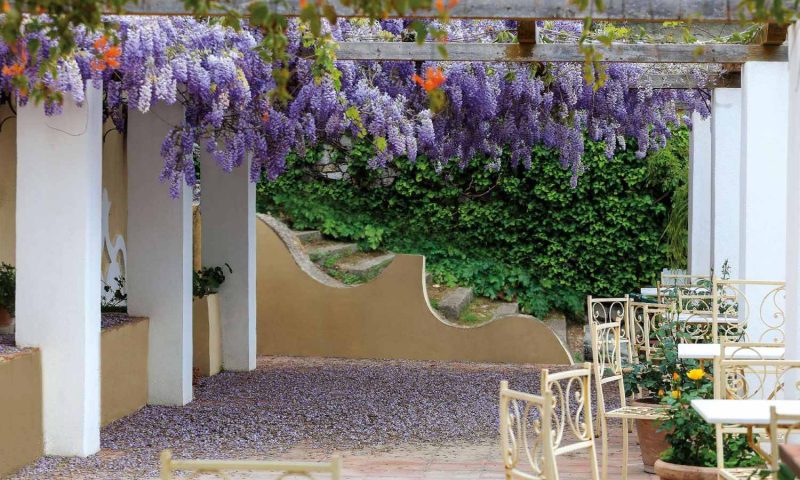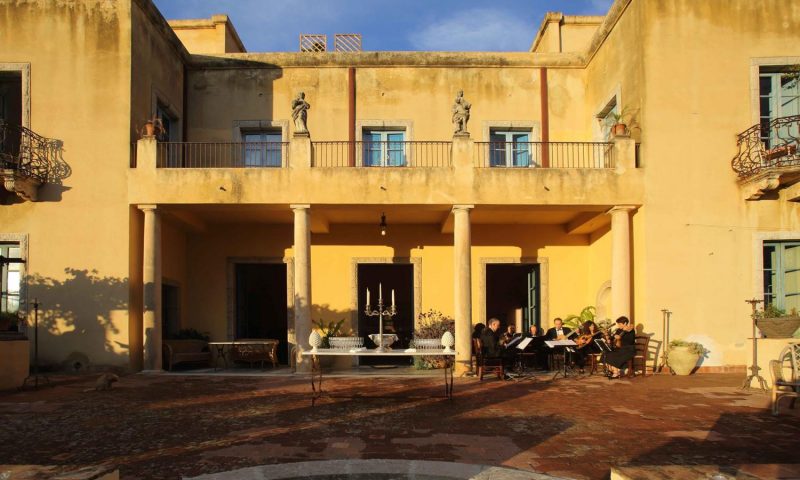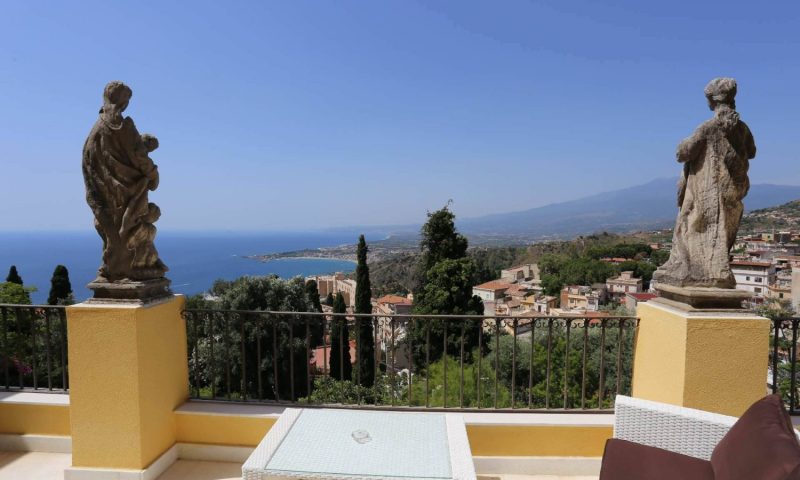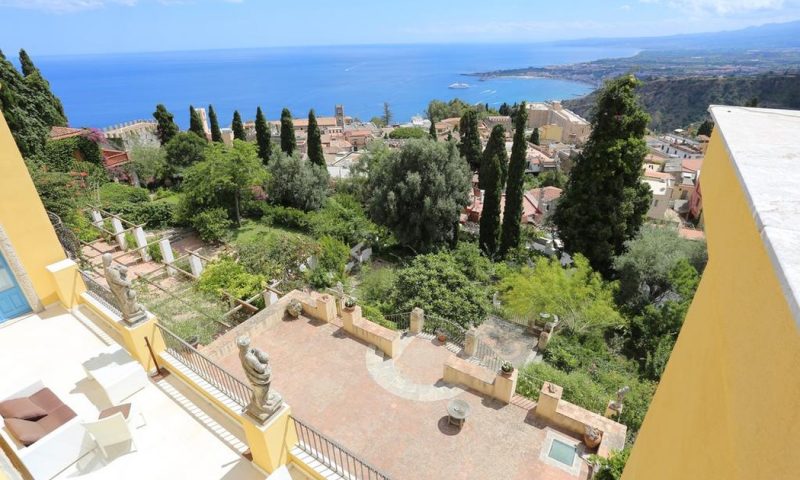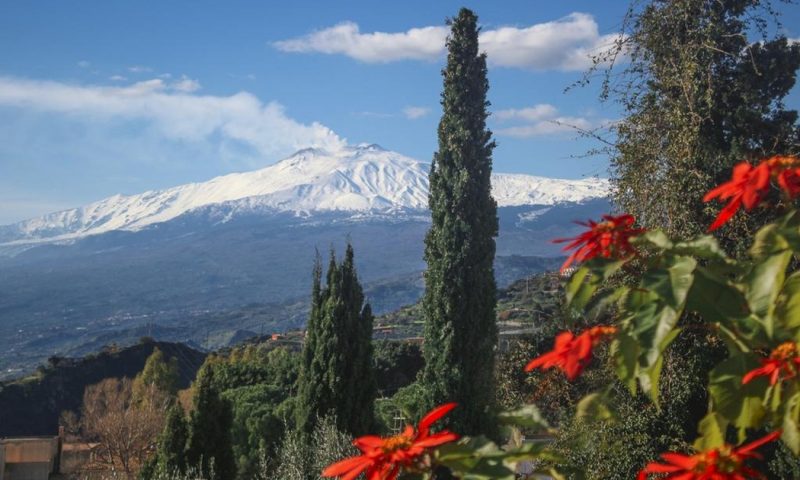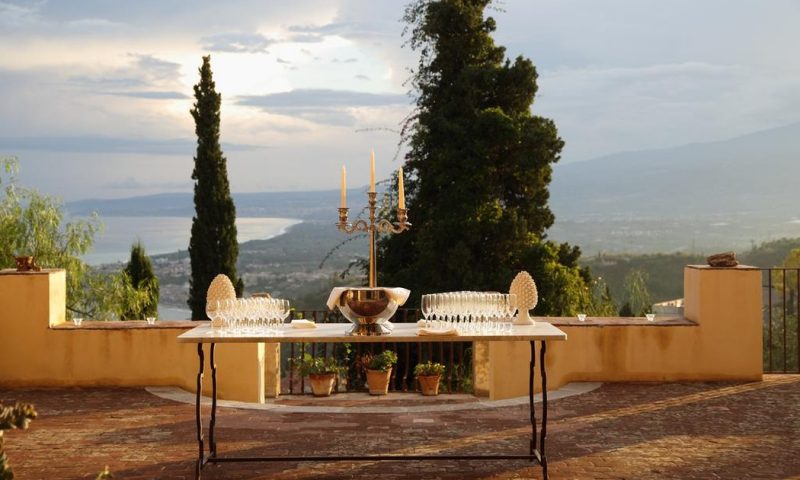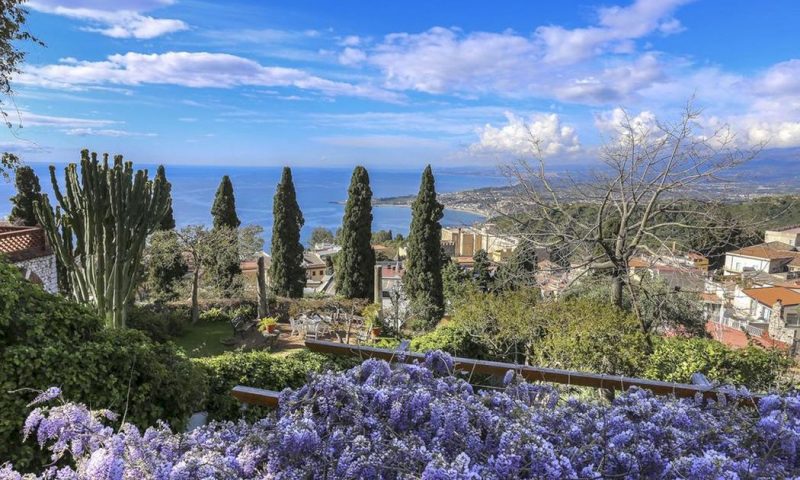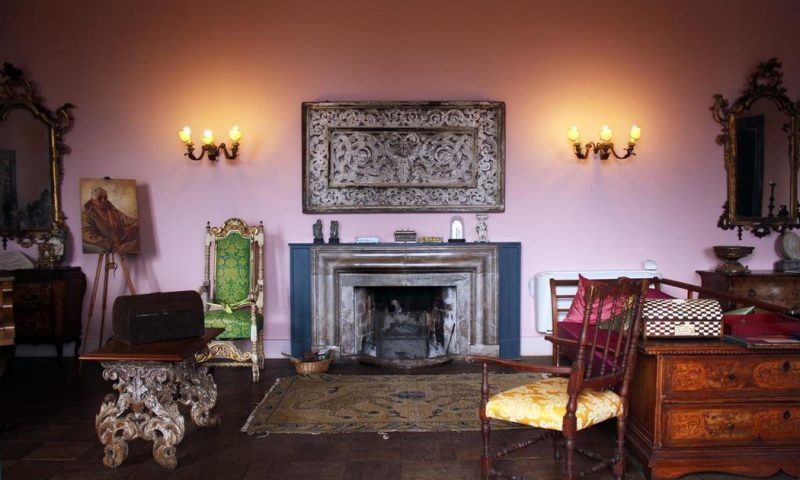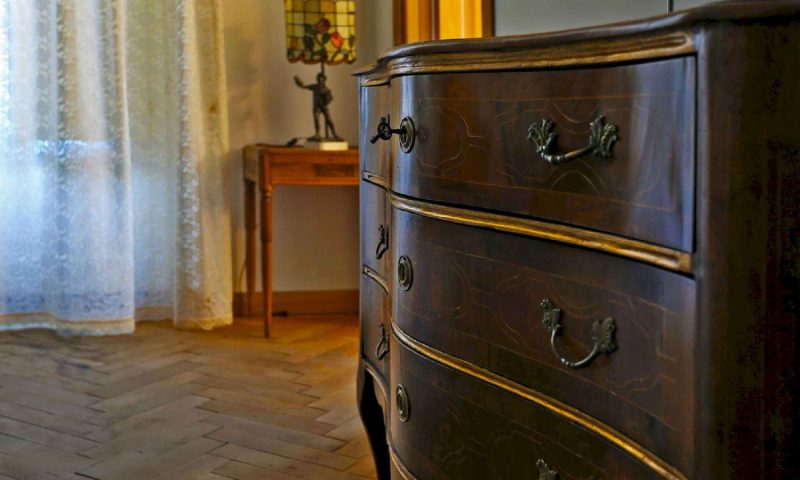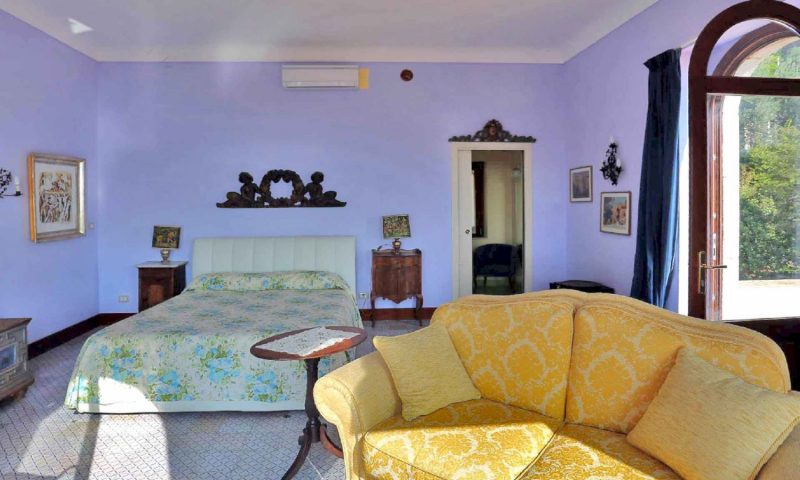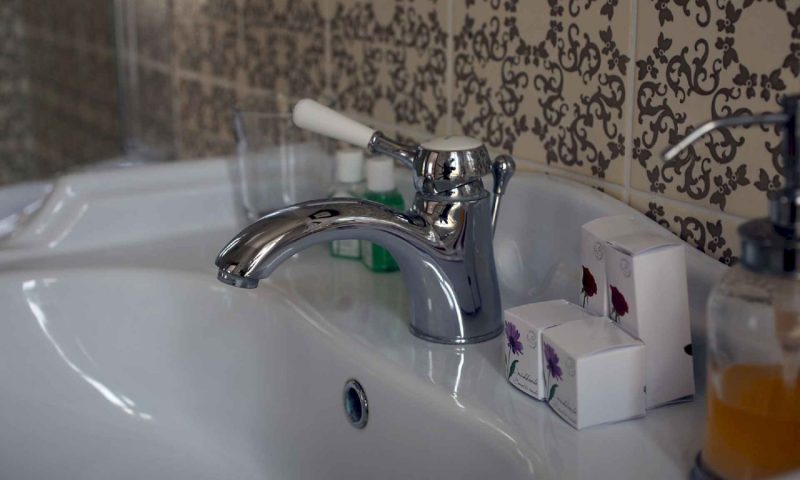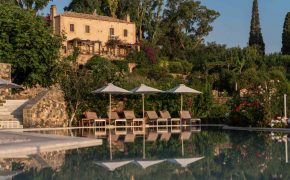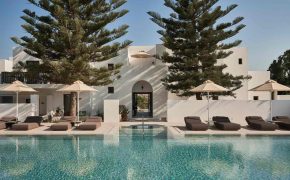Casa Cuseni was the first hotel for artists in Europe, in 1947. Today, as then, it is still open for hospitality. Here, Ernest Hemingway wrote his first novel, Lord Bertrand Russell won the Nobel Prize for Literature, Sir Frank Brangwyn, Sir Alfred East, Cecil Hunt, Sir George Clausen, painted Sicilian landscapes, Arthur Lasenby Liberty, Pablo Picasso, Henry Faulkner, Salvador Dali, Denis Mack Smith, Roald Dahl, Jocelyn Broke, Tennessee Williams and many others again, all found an ideal place to write, paint, or simply a magical place to rest as Greta Garbo was to discover.
Casa Cuseni is officially the Museum Centre of the City of Taormina. The full name is: Casa Cuseni, Museum of Fine Arts and of the Grand Tour of the City of Taormina. The Museum is open all year round, every day, holidays included, with reservation required.
Tours take place regularly every day at 11.30 a.m., they last from 60 to 90 minutes, in English from Monday to Friday, in Italian on Saturday and Sunday. Reservation required. Casa Cuseni at a glance.
PABLO PICASSO ART SUITE
The suite consists of an entrance hall, a small living room, a bedroom and a bathroom with bathtub, the latter designed and built in 1941 for the commander of the German occupation troops in Italy, Generalfeldmarschall Albert Konrad Kesselring.
It has been the bedroom of many artists, famous art critics, presidents of the Royal Society of British Artists, the Royal Watercolour Society of Art, Royal Society of Art painters, magistrates and writers. Among the many to stay here were Sir Alfred East, Sir Frank Brangwyn, Alfred Barr Jr, Salvador Dali, Cecil Hunt and Pablo Picasso.
The bathroom has been perfectly restored and reproduced with tiles of the same type and colour. The original wooden fittings in the bathroom were designed by Sir Frank Brangwyn in 1909.
The paintings and antique furniture in this room were declared part of the Italian National Cultural Heritage on 22 March 2021 and are therefore under the protection of the Fine Arts of Messina.
GRETA GARBO BRIDAL SUITE
This was the favourite room of the famous Swedish actress Greta Garbo during her first stay in Taormina. She chose this room for its panoramic terrace with a magical view of Mount Etna, Europe’s highest volcano, and the Gulf of Naxos below. It is the central room of the residence, bright, quiet, suitable for writing and painting or simply resting.
The room is furnished with 18th-century Sicilian furniture, with watercolours by Robert H. Kitson and works by another 20th-century master, the painter Corrado Cagli, who stayed at Casa Cuseni many times, together with the Spanish painter Salvador Dali and his wife Gala.
The paintings and antique furniture in this room were declared Italian National Cultural Heritage on 22 March 2021 and are therefore under the protection of the Fine Arts of Messina.
DON ROBERTO JUNIOR SUITE
This is Villa Cuseni’s most panoramic room. It is located on the second floor and was originally the villa’s painting studio, very quiet and with extraordinary natural light. Three windows, made like a Renaissance triptych, frame a panorama without equal in the world, with Mount Etna, the sea and the garden below.
The room is furnished with antique Sicilian furniture from the 1800s, with original Sicilian majolica floor tiles from the early 1900s, perfectly restored, and with paintings by Robert H. Kitson, the painter credited with making Taormina famous throughout the world, Don Roberto Kitson, as he was called in town.
This room, a junior suite, consists of a bedroom, a dressing room and a bathroom with shower. The paintings and antique furniture in this room have been part of the Italian National Cultural Heritage since 26 March 2021 and are under the protection of the Belle Arti.
DAPHNE PHELPS JUNIOR SUITE
This was the master bedroom, first inhabited by the famous English painter Robert Kitson and then by his granddaughter, the writer Daphne Phelps. The room has two magnificent Baroque-style balconies overlooking the garden, Mount Etna and the Gulf of Naxos, with a spectacular view of the sea.
It has natural light that makes it suitable for painting, writing and reading. It is furnished with rare and elegant 18th-century Sicilian furniture. Watercolours by Robert Hawthorn Kitson, depicting the garden of the villa, make the atmosphere of the room exclusive and welcoming.
The paintings and antique furniture in this room have been part of the Italian National Cultural Heritage since 26 March 2021 and are under the protection of the Fine Arts. Please treat them with good care.
The suite consists of an entrance hall, a small living room, a bedroom and a bathroom with bathtub, the latter designed and built in 1941 for the commander of the German occupation troops in Italy, Generalfeldmarschall Albert Konrad Kesselring.
It has been the bedroom of many artists, famous art critics, presidents of the Royal Society of British Artists, the Royal Watercolour Society of Art, Royal Society of Art painters, magistrates and writers. Among the many were Sir Alfred East, Sir Frank Brangwyn, Alfred Barr Jr, Salvador Dali, Cecil Hunt, Pablo Picasso.
The bathroom has been perfectly restored and reproduced with tiles of the same type and colour. The wooden fittings in the bathroom, original of the period, were designed by Sir Frank Brangwyn in 1909.
The paintings and antique furniture in this room were declared part of the Italian National Cultural Heritage on 22 March 2021 and are therefore under the protection of the Fine Arts of Messina.
HENRY FAULKNER DOUBLE ROOM
A terrace with an extraordinary panorama that takes in the Gulf of Naxos, the volcano Etna and the city of Taormina; the room is furnished with perfectly restored 18th century furniture and authentic works by the American painter Henry Lawrence Faulkner and Robert Hawthorn Kitson.
This room was chosen for Tennessee William, a frequent guest at the villa and a close friend of Henry Lawrence Faulkner. It was in this very room that the American writer Ernest Hemingway wrote his first short story, The Mercenaries, at Christmas 1918.
The paintings and antique furniture in this room were declared part of Italy’s national cultural heritage on 22 March 2021 and are therefore under the protection of the Fine Arts Department of Messina.
DINING ROOM
The dining room of Casa Cuseni is the only surviving interior in the world by Sir Frank Brangwyn, a member of the Royal Academy. The interior was created in Taormina in 1910 by the renowned Sir Frank Brangwyn, a British member of the Royal Academy, but concealed for over a hundred years because it tackled, in the Art Nouveau decoration of the murals, an issue that is still controversial and debated today: same-sex parenting.
The murals were made in Taormina, a place safe from the Labouchere Amendment, a law of 1885 that had convicted the poet Oscar Wilde in 1895. Exactly one century after its creation, the dining room of Casa Cuseni is now finally open to the public.
The room encapsulates the political and artistic thinking of John Ruskin and William Morris, the pre-Raphaelite painting of Dante Gabriel Rossetti and Edward Burne Jones, the architectural design of Josef Hoffmann, Charles Rennie Mackintosh and Philip Webb, all condensed in the magical brushwork of Sir Frank Brangwyn, the first decorator of Louis Comfort Tiffany.
In 2019, this interior was recognised as the world’s best example of the Arts and Crafts Movement outside Britain and was declared a Place of Identity and Memory of the Sicilian Region.
THE HISTORIC GARDEN
Built on the hill of Taormina, the Historic Garden of Casa Cuseni was created by Robert Hawthorn Kitson (1873-1947) at the beginning of the 20th century. Sir Frank Brangwyn, Sir Alfred East, Cecil Arthur Hunt, the Futurists Giacomo Balla and Fortunato Depero, each played a part in designing this garden using the landscape as the protagonist of the scene, making the mighty volcano Etna and the Gulf of Naxos a harmonious whole with nature.
This monument should viewed by acknowledging the influence of William Blake’s romanticism, John Ruskin’s utopian socialism and the mysticism and transcendentalism of the early 20th century, which also brought about a change in art; spiritualism contributed to the birth of abstractionism and the abandonment of conventional art forms.
The creators of the garden at Casa Cuseni concentrated on representing the spiritual rather than the physical world; symbols and geometry – languages of esotericism – and the symbolic use of colours as presented in theosophy became the distinctive signature, shifting traditional artistic representation in the direction of spirituality, where there was still hope of giving meaning to life.
For them, the artist has the task of awakening in humanity the memory of its own ‘divine’ condition, lost after the expulsion from Eden. The aim of art is the reconquest of Paradise, understood not as a ‘physical’ otherworld but as an interior space that man can regain through imagination.
The construction, in this garden, of a great Menorah, three Mikvehs and a Temple for purification confirms the existence, in Taormina, of a major international theosophical project, where art, with its colours, shapes and lines, represents a way of making visible events that belong to the astral world.
THE LIBRARY
The Sicilian Region decree D.D.G. no. 6252, 11 December 2018, states that the collection of books known as the “Casa Cuseni Book Collection”, pursuant to Article 13 of Legislative Decree no. 42 of 22 January 2004 and subsequent amendments and additions, is declared to be of major cultural interest, as it is listed among the assets noted in Article 10, paragraph 3, letter c) of the same Legislative Decree and in Article 2 of Regional Law No 80/77 and is therefore subject to all the protection provisions contained in the above-mentioned laws.
The book collection of the Casa Cuseni library comprises an older fund and a more modern fund specialising in Arts and Crafts Movements and in literature, which coexist together with material of a more properly archival nature, from private correspondence to notes of intellectual activity, from autograph annotations to paratextual material.
In a broader sense, this material fully recreates the profile of the owners and the events of their lives and of the many scholars who worked here – from Lord Bertrand Russell (who was informed that he had won the Nobel Prize for Literature in this library) to Anatole France and Denis Mack Smith (who wrote his entire monumental work on the history of Italy and Sicily in this library), as well as the writers Ezra Pound, Tennessee Williams, Roald Dahl, André Gide and Roger Peyrefitte (who wrote the books that made the city of Taormina famous).
It comprises various items from celebrated artists, from Salvador Dalì to Pablo Picasso, and the Presidents of the Royal British Art Academies – suffice it to mention Sir Frank Brangwyn, Sir Alfred East, Sir George Clausen, Richard Henry Wright and Cecil Arthur Hunt, but also all the Italian Futurist painters and sculptors, (Giacomo Balla, Fortunato Depero, Filippo Tommaso Marinetti), or again Duilio Cambellotti, who left in this house the photographs of his scenographies that would have been staged at the Teatro Antico.
Our archives are intact and are a precious source to those wishing to study the many artists who lived in Casa Cuseni, in order to better understand the library, its dynamics, and the cultural contextualisation of the archive.
The first owner, the British artist Robert Hawthorn Kitson, who conceived the core of the library and expanded it over the years, was a prominent local and international personality. In our management approach, we always take into account the author of the work. Only this knowledge can allow a proper handling of the library.
Some of the works we possess are extremely valuable and represent a unicum – as, on the other hand, does every printed copy – both from a bibliographical and bibliological point of view, and in the more broadly cultural context, in that they reflect the reading, study and training practices of the owner and of all the scholars gathered here.
Many of our specimens, catalogued by the Messina Heritage Board, are frequently accompanied by autographed dedications, ex libris, postils and handwritten notes in the margins of the text, and so on.
From this point of view, attention in cataloguing the specimens and their description is necessary, and a duty, particularly in a country like ours, heir to a prestigious literary and cultural tradition.
A specific attention that highlights their potential as sources for cultural and historical research. It would be desirable to carry out a scientifically controlled survey of the library, which would allow the researcher to grasp the geographical and cultural links between the collections of different authors present here, starting from their bibliographic, bibliological, paratextual and archival properties in our collections.
SICILIAN COOKING CLASS & ART NOUVEAU EXPERIENCE
Sicilian cuisine is the expression of the culinary art developed on our island since ancient times and is closely linked to its historical, political and religious events. The Arabs brought oranges and lemons, sugar cane and rice to the island, making the confectionery tradition of cassata, cannoli, granita, sorbets and ice cream possible.
Then came Imperial Spain with its spices imported from the Americas, and finally 18th century culture, with monarchical France and its famous Monsù (monsieurs), French chefs who were highly specialised in fine cuisine. In 2008, the worldwide recognition of this Mediterranean cuisine was added to the UNESCO World Heritage List.
Casa Cuseni has a very long tradition of Sicilian cuisine, with the first owner, the British artist Robert Kitson, who had the last Monsù of Taormina, then with Daphne and Concetta, who experimented by blending a wonderful Sicilian cuisine with some English flavours. Now for you, in the best historical tradition of Sicily and Casa Cuseni, the chefs of Villa Cuseni will introduce you to the history of Sicily through its flavours.
Guests will have a personal chef to assist them in the preparation of their food and can choose, in advance, the traditional Sicilian dishes they wish to make.
The cooking-lesson at Casa Cuseni is a unique and unforgettable experience because you will be assisted by professionals and have the opportunity to have lunch in the refined dining-room of the House or on one of our terraces with the magnificent view of the Gulf of Naxos and Mount Etna, the highest volcano in Europe.
It is hoped you will take home with you the memory of our views, the refined Sicilian hospitality and the recipes of our cook or the oldest ones of our last monsù, handed down from generation to generation.
